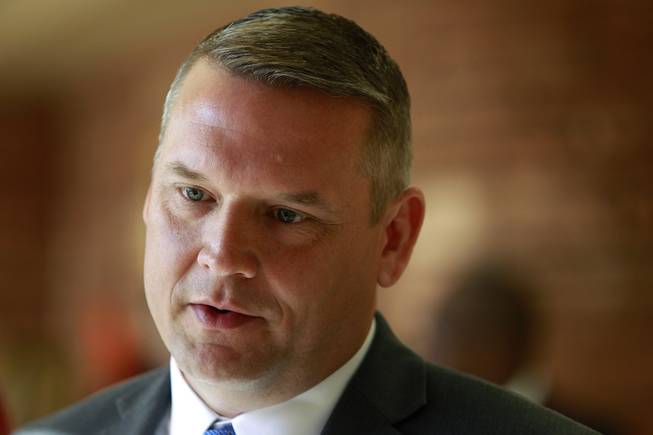
Sam Morris / Las Vegas Sun
John Entsminger talks to the media after being named the new general manager for the Las Vegas Valley Water District Tuesday, Jan. 7, 2014.
Saturday, June 28, 2014 | 2 a.m.
John Entsminger hasn’t wasted anytime getting his feet wet since taking the top job at the Southern Nevada Water Authority in January.
Three months into his tenure, the water authority and its sister agency, the Las Vegas Valley Water District, laid off 101 employees, a move Entsminger said was needed as the agencies evolve.
He’s also stepped in at a tense time on the Colorado River, with the recent drought in Northern California taxing water systems across the West.
Entsminger has big shoes to fill replacing water czar Pat Mulroy, who became a leading figure in Colorado River negotiations during her 25-year tenure and gave Nevada outsized influence despite its small share of river water.
Entsminger was Mulroy’s handpicked successor to take over after 15 years with the agency, including four as her chief deputy.
The Sun sat down with Entsminger to discuss the state of the Colorado River, progress on the third intake straw at Lake Mead and what’s next for water conservation in Southern Nevada. His answers have been edited for clarity and brevity.
One of your first major decisions since taking office was to lay off 101 employees. Why were those layoffs needed? Are any more expected?
Over the last 20 years, the water authority and the water district have been constantly responding to growth. Not just growth but hyper growth. Now having built $3 billion worth of infrastructure, it’s the time in our community’s maturation process for our agencies to begin to take care of that infrastructure and to be more of an operations and maintenance organization rather than a purely growth-supported organization. I view those layoffs as a one time evolutionary step for our organization, and that relates directly to what I just talked about. I don’t believe any others are going to be needed.
What’s the status of construction on the third intake straw at Lake Mead?
What the engineers are saying is about a year from now, so midsummer 2015, they hope that the tunneling work will be substantially complete. Then you probably have four to six months to make sure everything’s ready to go before you turn it on and start actually supplying water through it.
What about the $12 million emergency construction to keep the first intake straw working even as the lake’s elevation declines? Will we be able to make it through the summer with only one intake currently functioning?
Intake one is still down; we’re not pulling water out of it. It’s not 100 percent complete, but we’re very close. We’re thinking weeks, not months. We haven’t gotten to the hottest part of the summer, but on that quintessential July 15 day when it’s 113 degrees out there, our projections are that peak demand would be 570 million gallons per day. (Our) intake pumping station can pump 720 million gallons per day, so we have a buffer.
What’s happening on the Colorado River? What conversations are you having with leaders from other states?
The states are back at the table having what I consider to be a very serious dialogue around what are our contingency plans if the elevations in Lake Mead and Lake Powell continue to go down.
The number one thing that’s complicating our efforts on the Colorado right now is the drought in Northern California. That’s putting (Southern California) in a position where it has to draw more water off the Colorado River. To now say, ‘OK, California, on top of the drought, we have to talk about all of us using less water to preserve Lake Mead and Lake Powell,’ it’s not a great time to be having those discussions.
If the drought persists and Lake Mead continues shrinking, what type of conservation measures would be needed in Southern Nevada?
We haven’t reached the point of diminishing returns on our current programs. Our conservation department estimates we’ve achieved about half of what we think we can get out of the voluntary programs like water smart landscapes.
That’s going to continue to be where our best bang for the buck is — getting a reduction in spray irrigation in our community. That’s the largest user of outdoor water.
We get asked repeatedly by the environmental community and business community about more measures indoors, but that doesn’t actually save any water.
What’s next is a renewed focus on a reduction in outdoor use, particularly on spray irrigation and turf. But that doesn’t mean getting rid of every blade of grass. We’re going to want large turf functions in our community. We want soccer fields. We want parks.

Join the Discussion:
Check this out for a full explanation of our conversion to the LiveFyre commenting system and instructions on how to sign up for an account.
Full comments policy